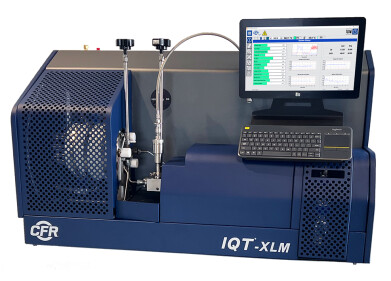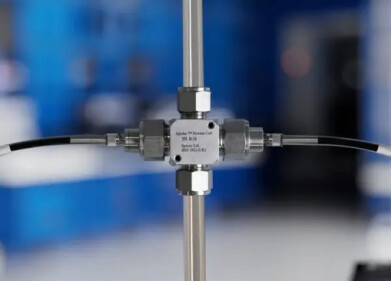-
 Figure 1: GC-VUV chromatogram of a pilot ILS gasoline sample zoomed-in to show the co-elution of methanol (0.05% by volume) with iso-butane. VUV AnalyzeTM performs automated spectral matching and deconvolution of co-eluting analytes. The bottom panel shows a time slice spectral fit with methanol, which elutes on the tail of the iso-butane peak.
Figure 1: GC-VUV chromatogram of a pilot ILS gasoline sample zoomed-in to show the co-elution of methanol (0.05% by volume) with iso-butane. VUV AnalyzeTM performs automated spectral matching and deconvolution of co-eluting analytes. The bottom panel shows a time slice spectral fit with methanol, which elutes on the tail of the iso-butane peak.
Analytical Instrumentation
ASTM Method D8071 Interlaboratory Study (ILS) to Expand Fuel Sample Scope
Aug 08 2017
VUV Analytics, Inc. will be exploring the inclusion of a broader scope of fuel samples that can be covered by ASTM Method D8071 during its interlaboratory study (ILS). Known also as “Standard Test Method for the Determination of Hydrocarbon Group Types and Select Hydrocarbon and Oxygenate Compounds in Automotive Spark-Ignition Engine Fuel using Gas Chromatography with Vacuum Ultraviolet Absorption Spectroscopy Detection (GC-VUV),” it was approved by the D02 committee for use with finished gasoline. Initial studies indicate the method’s applicability to a range of gasoline, oxygenated gasoline, and refinery stream samples. Examples of the scope expansion are the specific inclusion of FCC, reformates, light and heavy naphthas, and alkylates; as well as a more comprehensive suite and concentration range of oxygenates such as ethanol, methanol, MTBE, ETBE, and others. The ILS has also been designed to allow for ASTM D6708 equivalency to EPA methods.
ASTM Method D8071 provides complete PIONA compound class characterization in a single measurement, potentially replacing the use of multiple legacy methods for this analysis. VUV Analytics promotes the method as having relatively simple instrumentation combined with automated analysis software that results in shorter run times and a more robust production solution than ASTM methods D6730 and D6839, and having the potential to replace the use of multiple ASTM methods (e.g. D5769, D5580, D1319, D6550, D3606, D4815, D5599, D5845) for measurement of finished gasoline.
Measurement of bulk composition of hydrocarbon groups and individual compounds in gasoline is important for quality control as well as ensuring compliance with various governmental regulations. As such, multiple ASTM methods exist for measuring various aspects of gasoline samples. VUV Analytics asserts that most of the legacy methods are limited in scope to a subset of hydrocarbon groups or specific compounds of interest, meaning that multiple methods are required for typical production control. More comprehensive methods such as ASTM D6730 and ASTM D6839 tend to involve complicated instrumentation and/or setup procedures. These methods have no inherent ability for self-monitoring of measurement results (e.g., fit criteria or similar), and instead rely on precise definition and control of retention times, resulting in more error-prone production measurements.
VUV Analytics guarantees that the commercial application VUV PIONA+™ for gasoline measurement is fully compliant with Method D8071. VUV PIONA+™ is enabled by the VGA-100 vacuum ultraviolet (VUV) absorption GC detector and an analysis engine called VUV Analyze™. GC-VUV absorbance data is inherently three dimensional (time, absorbance, wavelength) and specific to compound chemical structure. This characteristic lends itself to intentional chromatographic compression due to the ability to deconvolve overlapping spectral responses. Formerly complex chromatographic separations can be simplified and shortened using the GC-VUV single-column solution. VUV absorbance spectra are typically highly structured and distinct for individual compounds, yet exhibit the intuitive property of having similar features when measuring related compound classes.
The VUV Analyze™ engine implements equations and fit procedures that result in deconvolution of absorbance spectra that contain contributions from multiple species, is capable of binning and storing response contributions from each deconvolution analysis, and reporting a combined total response at the end of the analysis. The data processing includes a database library of VUV reference spectra, compound class information, density, approximate retention index values, relative response factors for each hydrocarbon class, and relative response factors for individually reported compounds. The compound class or specific compound concentrations can be reported as mass or volume percent.
VUV PIONA+™ via ASTM D8071 uses straightforward instrumentation: a gas chromatograph, a standard 30m nonpolar column, and a VGA detector. Bulk concentrations of the hydrocarbon classes of paraffins, isoparaffins, olefins, naphthenes, and aromatics (PIONA) are determined. Specific analytes can also be singled out for further characterization. The setup procedure is easy and requires no pre-column tuning or valve timing adjustments. Additionally, faster runtimes can be achieved given the method’s ability to handle co-elution among various species and hydrocarbon classes. Figure 1 shows a GC-VUV chromatogram of a pilot ILS gasoline sample zoomed to show a co-elution resolved by VUV PIONA+™. A small amount of methanol (0.05% by volume) co-elutes with iso-butane in the tail of the chromatographic peak that begins at approximately 2.1 minutes. The spectral profile of this oxygenate is shown in the bottom panel along with its residual value assessment of the fit. VUV Analyze™ ensures the accuracy of this type of compound identification by rapidly fitting the analyte absorbance data with known spectral profiles in the VUV library. In addition, the software performs deconvolution within time slice intervals to determine the contribution of co-eluting analytes to the sum absorbance peak. The unambiguous identification of compounds and compound classes by VUV PIONA+™ has enabled the anticipated scope expansion of fuel stream samples characterized by ASTM Method D8071 to be explored during the interlaboratory study.
Digital Edition
PIN 25.5 Oct/Nov 2024
November 2024
Analytical Instrumentation - Picturing Viscosity – How Can a Viscometer or a Rheometer Benefit You? - Sustainable Grease Formulations: Evaluating Key Performance Parameters and Testing Method...
View all digital editions
Events
Dec 03 2024 Dusseldorf, Germany
Dec 08 2024 Anaheim, CA, USA
Turkey & Black Sea Oil and Gas
Dec 11 2024 Istanbul, Turkey
Dec 19 2024 Aurangabad, India
Jan 20 2025 San Diego, CA, USA


















